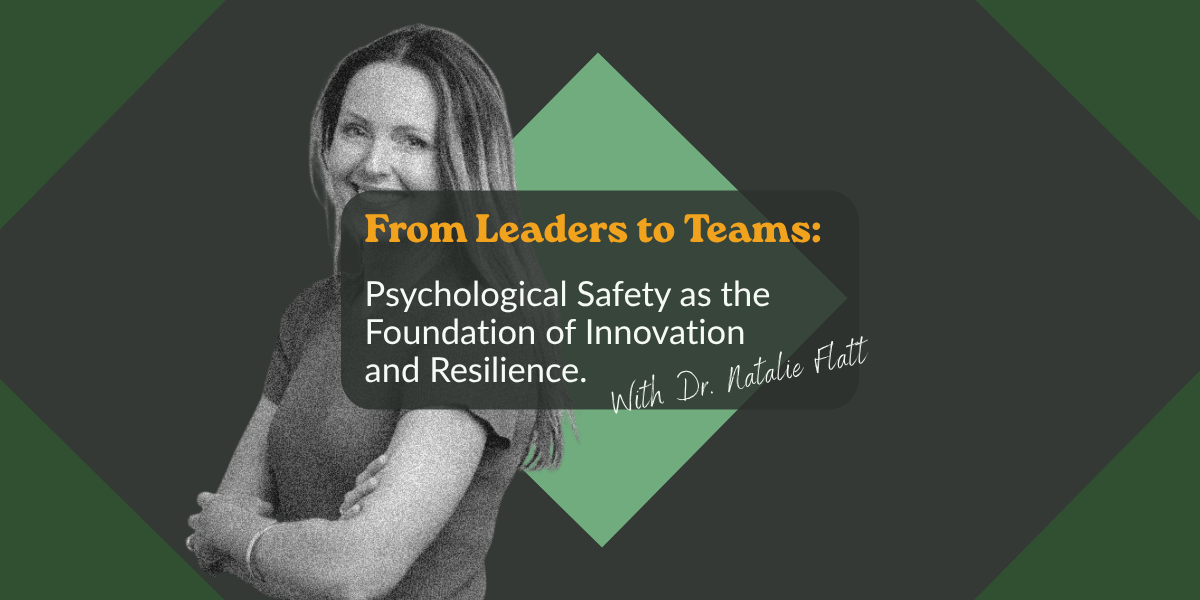In today’s workplaces, change and pressure are constant. Industries are transforming, technology is disrupting, and the demand for innovation is relentless. What separates resilient, high-performing teams from those that burn out isn’t just skill or resources, but whether people feel safe enough to speak up.
This is where psychological safety comes in.
What Is Psychological Safety?
First introduced by Harvard’s Amy Edmondson, psychological safety is the “shared belief that the team is safe for interpersonal risk-taking.” In simple terms, it means knowing you won’t be punished, embarrassed, or ignored for asking a question, making a mistake, or sharing an idea.
And the evidence is powerful:
- Gallup (2023): Teams with high psychological safety experience 27% lower turnover, 40% fewer safety incidents, and 12% higher productivity.
- Deloitte (2020): Organisations with inclusive cultures (a hallmark of psychological safety) are six times more likely to be innovative and twice as likely to meet or exceed financial targets.
Psychological safety isn’t a “nice-to-have.” It’s a business-critical foundation for performance, retention, and resilience.
Get fresh H&S insights weekly
Why Psychological Safety Matters for the Brain
Psychological safety isn’t about being nice or avoiding conflict. It’s about creating an environment where curiosity, honesty, and accountability are valued.
From a neuroscience perspective, the stakes are even higher. When people feel threatened, worried about being judged or punished, the brain’s amygdala (fear centre) triggers fight-or-flight mode, shutting down access to the prefrontal cortex, which governs creativity, empathy, and problem-solving.
Fear narrows thinking. Safety broadens it.
That’s why psychologically safe workplaces don’t just feel better but perform better.
Psychological vs. Psychosocial Safety
These terms are often confused, but they serve different purposes:
- Psychosocial safety is about preventing harm. Managing risks like workload, bullying, or unclear roles. These hazards appear in Australia’s WHS Codes of Practice and, left unmanaged, can lead to burnout or claims.
- Psychological safety is about enabling growth, encouraging people to share ideas, ask for help, and admit mistakes without fear.
Together, they reinforce each other. A team that feels safe will raise concerns early and collaborate on solutions, preventing psychosocial risks from escalating into harm.
Moving Beyond Policy: Embedding Safety into Systems
Many organisations have beautifully written wellbeing policies, but staff quickly notice when policies don’t align with lived experience. That gap erodes trust faster than any single bad day.
To make safety more than a buzzword, embed it into systems:
1. Measure it – Use Edmondson’s survey, PSC-4, or pulse checks.
2. Add it to the risk register – If it’s not named, it’s ignored.
3. Close the loop – Act on concerns; silence damages trust and is worse than mistakes.
4. Check perceptions – Real culture is how staff feel, not what leaders think.
5. Prioritise empathic leadership – Leaders who listen, show understanding, and respond with empathy foster psychological safety. This reduces stress and conflict and strengthens trust, retention, and performance across teams.
Leaders have to feel confident in how to deliver a psychologically safe workplace. Treating psychological safety as a risk management tool elevates it from “soft skills” to serious business.
Leadership: The Critical Factor
Leaders don’t need psychology degrees, but they do need emotional intelligence. Teams unconsciously “catch” their leader’s emotional state; calm leaders create calmer teams.
SuperFriend (2024): When leaders respond empathetically to mental health disclosures, intent to stay rises to 85%. A dismissive response does the opposite.
Traits that matter most:
- Curiosity – Ask instead of assuming.
- Humility – Admit mistakes and learn.
- Consistency – Predictability builds trust.
Authentic leadership reduces stigma and builds resilience.
Practical Tools for Everyday Safety
Psychological safety is built in micro-moments, not just workshops. A nod can build confidence; an eye-roll can silence someone for months.
Leaders can:
- Use speak-up rounds to give everyone airtime.
- Provide anonymous channels for quieter voices.
- Follow through on feedback.
- Set guardrails for debate - focus on ideas, not people.
Each time someone speaks up and sees action, trust compounds.
Recognising When Stress Turns Harmful
Normal stress is inevitable. Chronic, harmful stress isn’t. Warning signs include absenteeism, presenteeism, withdrawal, or conflict.
Solutions:
- Redesign tasks.
- Redistribute workload.
- Clarify roles.
- Escalate issues early to EAPs or support systems.
- Ensure you have real-time access to data insights on Employee Mental Health.
Early intervention protects staff and prevents long-term harm.
Seven Strategies for Action
Awareness isn’t enough; leaders need action.
1. Diagnose before prescribing – Measure, share results, and involve staff.
2. Build micro-behaviours – Start meetings with check-ins, rotate agenda leads, end with “What did we miss?”
3. Hold leaders accountable – Link culture metrics to performance reviews.
4. Integrate with risk management – Track safety like physical hazards.
5. Set guardrails for conflict – Use feedback models and team norms.
6. Embed recognition and repair – Celebrate risk-taking and repair quickly after missteps.
7. Act early on stress signals – Spot issues, redistribute workload, and escalate before harm.
Measuring What Matters
What gets measured gets managed. Use:
- Surveys for quantitative insights.
- Focus groups for qualitative depth.
- Trend tracking for early warnings.
Perception counts most. If employees feel unsafe, their bodies react as if they are unsafe - intent doesn’t erase impact.
Final Thoughts
Psychological safety isn’t about making workplaces comfortable; it’s about making them effective. When fear is reduced, higher brain functions stay online, enabling creativity, empathy, and problem-solving.
By embedding safety into systems, instilling emotionally intelligent leadership, and reinforcing it in daily moments, organisations create the conditions for innovation and resilience.
Leaders can start today by asking:
1. Do my team members feel safe enough to tell me the truth?
2. When someone speaks up, do they see follow-through?
3. What small behaviour change can I make this week to show openness?
Workplaces that get this right don’t just survive uncertainty; they thrive in it.
Want to hear more from Dr. Natalie Flatt and her work at Connect Psych? Follow her on Linkedin at: https://www.linkedin.com/in/drnatalieflatt/


